Chapter 13 Photosynthesis in Higher Plants
Class 11th Biology Important Questions
Class 11 Biology Chapter 13 Important Extra Questions Photosynthesis in Higher Plants
Photosynthesis in Higher Plants Important Extra Questions Very Short Answer Type
Question 1.
What is the full form of NADP?
Answer:
Nicotinamide
Adenine Dinucleotide phosphate.
Question 2.
What are the complete photosynthetic units of plants?
Answer:
Chloroplasts.
Question 3.
Give one difference between chlorophyll ‘a’ and chlorophyll
‘b’.
Answer:
Chlorophyll (a) has a methyl group (CH3) whereas
chlorophyll (b) has an aldehyde group (CHO).
Question 4.
How many ATP molecules are required for the synthesis of one
molecule of glucose in the C3 pathway?
Answer:
18 ATP molecules
are required for the synthesis of one molecule of glucose.
Question 5.
In which part of the leaves chlorophyll is found?
Answer:
In the thylakoid membrane of the chloroplast.
Question 6.
What is the primary acceptor of C02 in the C3
plant? ,
Answer:
RiBulose 1.5 biphosphate (RuBP).
Question 7.
In which part of chloroplast light reaction takes place?
Answer:
Grana.
Question 8.
What is the relation between photosynthetic units and reaction
centers?
Answer:
A photosynthetic unit consists of P6g0 and P700 reaction
centers of photosystems.
Question 9.
What is the compensation point?
Answer:
The point at
which the rate of photosynthesis is equal to the rate of respiration.
Question 10.
What is Kranz’s anatomy?
Answer:
It is a type of leaf
structure in which the vascular bundle is surrounded by bundle sheath and
mesophyll cells.
Question 11.
Which kinds of reactions of photosynthesis occur in the grana
and stroma of chloroplasts?
Answer:
- Grana light reaction
- Stroma dark reaction
Question 12.
Give the overall general chemical equation of
photosynthesis?
Answer:
Question 13.
Expand the abbreviation RuBP, NADP
Answer:
RuBP:
Ribulose biphosphate
NADP: Nicotinamide Adenine Dinucleotide Phosphate
Question 14.
Give two points of difference between sun plants and shade
plants.
Answer:
Sun plants need relatively high light intensity to
saturate their photosynthetic rates while shade plants reach saturation at low
intensities.
Question 15.
Name the process which is responsible for converting solar
energy into chemical energy.
Answer:
Photosynthesis
Question 16.
Wherefrom does oxygen come out during photosynthesis?
Answer:
From water
Photosynthesis in Higher Plants Important Extra Questions Short Answer Type
Question 1.
Expand the abbreviation RuBP. What is its role in
photosynthesis?
Answer:
The full form of RuBP is ribulose 1,5 biphosphate;
RuBP is the first acceptor of atmospheric CO2 during the dark
reaction of photosynthesis. The reaction is called carboxylation.![]()
RuBP is regenerated during the final formation of sugar
molecules.
Question 2.
What is the porphyrin system?
Answer:
The porphyrin
system consists of
- A complex ring structure of alternating single and double bonds called a porphyrin ring having four pyrrole rings containing a magnesium atom in the center.
- A lengthy hydrocarbon tail attached to the porphyrin group called phytol.
Question 3.
What are the two main functions of pigments other than
chlorophyll in green leaves?
Answer:
The functions of pigments other than
chlorophyll are:
- to absorb light energy and transfer it to chlorophyll for photosynthesis.
- to protect the chlorophyll molecule from photooxidation.
Question 4.
What is the significance of chlorophyll-a in photosynthesis
carried out by higher plants?
Answer:
In higher plants, all the pigments
carotenes, xanthophylls, and chlorophyll-b transfer the absorbed solar energy to
chlorophyll-a. It is the chlorophyll-a molecule, which initiates the process of
photosynthesis.
Question 5.
Write two differences between cyclic and non-cyclic
photophosphorylation?
Answer:
Differences between cyclic and non-cyclic
photophosphorylation:
| Cycle-photophosphorylation | Non-cyclic-photophosphorylation |
| (i) Reaction center P700 is the electron emitter and also electron acceptor | (i) Reaction center P680 is the electron emitter and P700 is the electron acceptor. |
| (ii) It synthesizes only ATP. | (ii) It forms both ATP and NADPH, |
Question 6.
What are the steps that are common to C3 and
C4 photosynthesis?
Answer:
The following steps are common in
both C3 and C4 photosynthesis.
- Photolysis of H2O and photophosphorylation in the light reaction.
- The dark reaction occurs in the stroma in both cases.
- Carboxylation-but in C3 plants CO2 acceptor is RuBP whereas in C4 it is phosphoenolpyruvic acid.
- The Calvin cycle resulting in the formation of starch occurs in both C3 and C4 photosynthesis.
Question 7.
What is the coupling factor in photosynthesis?
Answer:
These are similar to the F0– F1 complex of mitochondria
present in appressed and non-appressed regions, granular and stromal thylakoids.
These participate in the photophosphorylation process.
Question 8.
What is 3 – PGA?
Answer:
It is a protein molecule
located on the outer surface of the thylakoid membrane. It is the first stable
intermediate product of photosynthesis. It comprises 16% of the chloroplast
protein, which is the most abundant protein of the biological world on
earth.
Question 9.
What is the Emerson effect or photosynthetic enhancement?
Answer:
Emerson in 1957 showed that the rate of photosynthesis can be
increased if monochromatic beams of two different wavelengths i.e. long and
short are used simultaneously around a trap center in a photosynthetic unit.
This phenomenon is known as the Emerson effect or photosynthetic
enhancement.
Question 10.
What is translocation in plants?
Answer:
The process of
long-distance movement of organic substances synthesized during photosynthesis
from chlorophyll-containing cells or leaf which serve as regions of supply or
source to different plant organs as regions of their utilization of sink is
known as translocation. The term translocation is generally restricted to
movements of solutes in the tissues of the phloem and xylem of plants.
Question 11.
Describe the process of photorespiration.
Answer:
It is
a process of loss of photosynthetically fixed carbons, occurring in some plants
during intense heat and low carbon dioxide concentrations. Under these
conditions the enzyme RuBP oxygenase and converts Ribulose Bisphosphate (5
carbon), into phospho-glyceric acid (3 carbon) and phosphoglycolate (2 carbon).
Soon glycolate is formed of phosphoglycolate. In peroxisomes, glycolate soon
changes into glycine and glycine into serine and CO2 without the
production of assimilatory powers (ADT and NADPH2). All the changes
taking place as follows.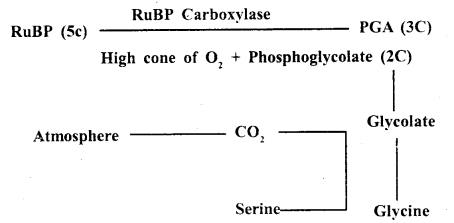
Photorespiration is also called the
C2 cycle because 2 carbon compounds are formed during the process.
This process does not field any unstable or free energy in the form of ATP.
Question 12.
Explain the following:
(i) There will be no life without
photosynthesis.
Answer:
For the existence of life, food and O2
are very essential. Photosynthesis is the only process that can trap solar
energy and can synthesis food for own and all other organisms. During
photosynthesis, O2 is given out and CO2 is taken. So, it
keeps the balance of O2 and CO2 in nature. Thus,
photosynthesis is essential for the existence of life.
(ii) There is no oxygen evolution in bacterial photosynthesis.
Answer:
In bacterial photosynthesis, the raw material for the supply of proton
(H+) is H2S than H2O. Thus, there are
productions of S than O3 during splitting in light reaction.
2
H3S → 2 HS + 2H+
HS + HS → H2S + S
(iii) Chlorophyll is an essential photosynthetic pigment.
Answer:
Chlorophyll-b and other pigments of a reaction center of photosystem absorb
solar energy and transfer it to chlorophyll-a. Ultimately it is the
chlorophyll-a that initiates the photosynthesis process. Solar energy enters
into the ecosystem only through photosynthesis.
Question 13.
What is the role of NADP in photosynthesis?
Answer:
NADP is a co-enzyme useful in photosynthesis when non-cyclic
photophosphorylation occurs, water is split. [n such a situation NADP acts as an
acceptor of electrons and protons to form NADPH. This NADPH is used as reducing
power for the fixation of CO2 in the dark reaction. If the dark
reaction is slow, then oxidized NADP will not be available and the non-cyclic
cycle will then cease to operate.
Question 14.
Give four important differences between photosynthesis and
respiration.
Answer:
| Photosynthesis | Respiration |
| 1. Occurs only in green cells. | 1. Occurs in all Living cells. |
| 2. Occurs in chloroplasts in the cell. | 2. Occurs in mitochondria. |
| 3. Needs light to occur. | 3. Does not need light. |
| 4. Uses CO2 and water. | 4. Uses glucose and oxygen releases CO2 and water. |
| 5. It ïs a constructive process. | 5. It is a destructive process. |
Question 15.
Explain the principle of limiting factor with a suitable
graph.
Answer:
Law of limiting factor: When a chemical reaction is
conditioned as to its rapidity by a number of separate factors then the rate of
reaction is as rapid as the slowest factor permits.
As is clear that as the light intensity is increased the rate of photosynthesis increases proportionately until some other factor like CO, becomes limiting. Ultimately the plant becomes light-saturated indicating that light is no more the limiting factor. If now the cone, of CO, is increased the rate of photosynthesis increases until the light becomes a limiting factor.
Question 16.
(i) List the three categories of photosynthetic pigments.
Answers:
Chlorophylls, Carotenoids, Phycobilins.
(ii) Which pigments are known as accessory pigments and why?
Answer:
Carotenoids and phycobilins.
They absorb light in the wavelength range not
absorbed by chlorophyll and transfer it to chlorophyll.
Question 17.
(i) What does chlorophyll do to the light falling on it?
Answer:
Chlorophyll molecule becomes excited as soon as light falls on it. It
was given out an electron acceptor which returns to release gradually energy in
the form of ATP.
(ii) Which pigment system absorbs the red wavelength of light?
Answer:
Photosystem I.
Question 18.
Name the two main sets of reactions in photosynthesis in
which light energy is required write down the reaction.
Answer:
(i)
Photolysis for breaking down of water molecule.
energy![]()
(ii) Photophosphorylation for the conversion
of light energy into chemical energy.
ADP + iP → ATP
Photosynthesis in Higher Plants Important Extra Questions Long Answer Type
Question 1.
What is photorespiration? Describe the process in detail and
link it with the Calvin cycle.
Answer:
Enzyme Rubisco catalyzes the
carboxylation reaction where CO2 combines with RuBP. This enzyme
catalyzes the combination of O2 with RuBP called oxygenation.
Respiration that is initiated in chloroplasts and occurs in light only is called
photorespiration.
The oxygenation of RuBP in presence of O2 is the first of photorespiration, which leads to the formation of one molecule of phosphoglycolate, a two-carbon compound, and one molecule of PGA. While PGA is used up in the Calvin cycle, the phosphoglycolate is dephosphorylated to form glycolate in the chloroplast and in turn diffused to peroxide, where it is oxidized to glyoxylate.
In the peroxide, the glyoxylate is used to form amino acid and glycine-calycine enters mitochondria where two glycine molecules (4 carbon) give rise to one molecule of serine (3 carbon) and one CO2 (one carbon). The serine is taken up by peroxisome and converted into glycerate. The glycerate enters the chloroplast where it is phosphorylated to form PGA. PGA molecules enter the Calvin cycle to make carbohydrates releasing one molecule of CO2 In mitochondria photorespiration is also called the photosynthetic carbon oxidation cycle.
Increased O2 level increases photorespiration whereas increased CO2 level increases photorespiration ( and increases C2 photosynthesis).
In C3 plants photosynthesis occurs only in one cell type i.e. mesophyll cells. Both light reactions and carbon reactions occur in mesophyll cells in C3 plants. In C4 plant photosynthesis requires the presence of two types of photosynthesis cells that is mesophyll cells and bundle sheath cells. The C4 plants contain dimorphic chloroplasts, which means chloroplasts in mesophyll cells are granular. Therefore C2 pathway does not operate in the C4 pathway.
All the important changes can be summarised as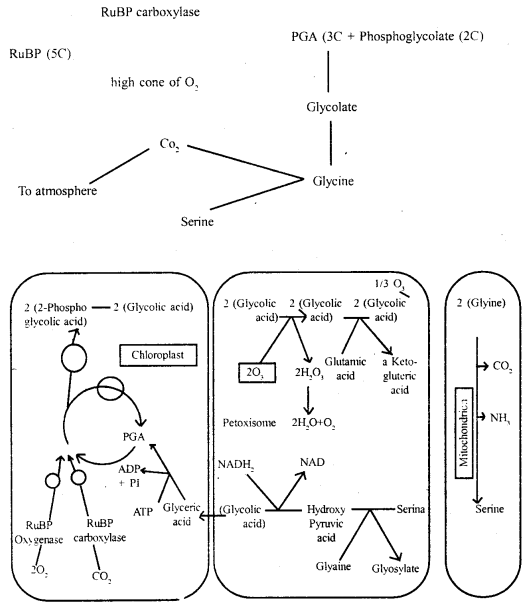
Question 2.
Describe carbon reactions of the C3 pathway. Does
this pathway operate also in C4 plants?
Answer:
The reactions
catalyzing the assimilation of CO2 to carbohydrates take place in the
stroma where all the necessary enzymes are localized. These reactions are
referred to as ‘carbon reactions’ (also called dark reactions) leading to the
photosynthetic reduction of carbon to carbohydrates.
In the first phase of carbon reaction, C02 enters the leaf through the stroma. This CO2 is accepted by a 5-carbon molecule, ribulose-1-5 bisphosphate (RuBP) already present in the leaf. It forms two molecules of 3-carbon, compound, 3- phosphoglycerate (PGA). This 3-carbon molecule is the first stable product of this pathway and hence it is called C, PATHWAY.
The formation of (PGA) with CO2 combining with RuBP is called carboxylation. This reaction is catalyzed by an enzyme called ribulose bisphosphate carboxylase (Rubisco). This enzyme also possesses oxygenase activity and hence abbreviated as Rubisco. This activity allows O, to compete with C02 for combining with RuBP.
After the carboxylation reduction of PGA occurs and ATP and NADPH, formed during photochemical reactions with the reduction of PGA, glyceraldehyde-3 phosphate-a carbohydrate is formed. These 3-carbon molecules, also called triose phosphates act as precursors for the synthesis of sucrose and starch. To complete the cycle, and to continue it, regeneration of the 5-carbon acceptor molecule, that is RuBP takes place.
The C3 type of carbon reaction occurs in the stroma of the chloroplast. This pathway is called the Calvin cycle.
The CO2concentrating mechanism is called the C4
pathway. Operation of the C4 pathway requires the cooperation of both
cell-type mesophyll and bundle sheath cells. The objective of the C. pathway is
to build up a high concentration of CO2 which suppresses
photorespiration. This C. pathway is more efficient than the C3
pathway. Hence C? pathway does not operate C4 plants. (See the
table)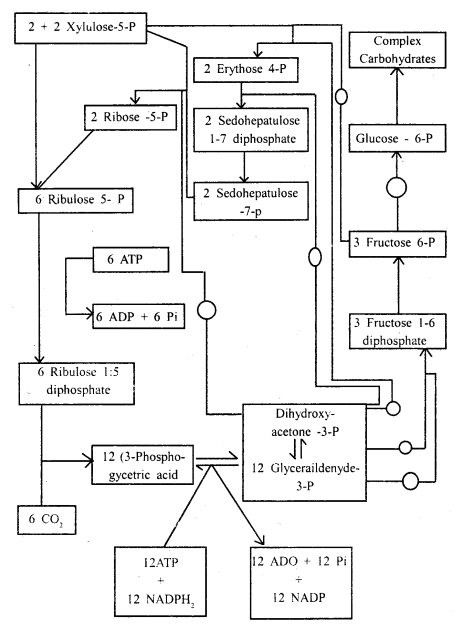
Schematic representation of C3
pathway Calvin cycle.
Question 3.
Describe briefly the experiment conducted by the scientist,
T.W. Englemann.
Answer:
T.W. Englemann plotted the action spectrum of
photosynthesis.
Photosynthesis can occur in visible light of wavelength varying between 390 to 763 nm. The rate of photosynthesis is not uniform in light of all wavelengths.
It varies depending upon their relative absorption by chlorophyll pigments.
The graph showing the relative yield or rate of photosynthesis in plants exposed
to monochromic light of different wavelengths is termed as ACTION SPECTRUM. The
rate of photosynthesis, as shown in the action spectrum is maximum in the blue
region of light.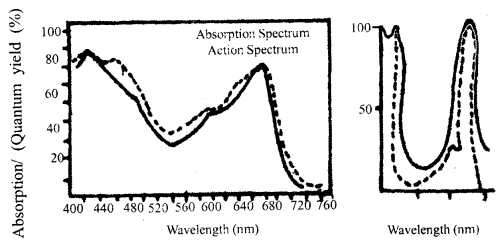
Curves showing a comparison of absorption
and action spectra of chlorophyll pigments during photosynthesis
Question 4.
What is a photosystem? Which is the pigment that acts as a
reaction center? Describe the interaction of photosystem 1 and photosystem
II.
Answer:
The light is entrapped by a group of chlorophyll molecules
which together constitute a photosystem. Each pigment system has a trap or
reaction center, which is either P700 or P680 ao. In this
‘P’ stands for pigment and figures 680 and 700 for the wavelength of light.
Chlorophyll molecule acts as a trap center with the transfer of high energy
electron to electron transport system (ETS).
The high-energy electrons return rapidly to their normal low energy orbitals in the absence of light and the excited chlorophyll molecule reverts to its original stable condition. These two photosystems: photosystem-I and photosystem-11 exist with different forms of chlorophyll ‘a’ as the reaction center. The PS-II is located in the appressed regions of grana thylakoids and the PS-I in the stroma thylakoids and non-appressed regions of grana.
The function of two photosystems that interact with each other is to trap
light energy and convert it to chemical energy (ATP). This chemical energy
stored in the form of ATP is used by living cells.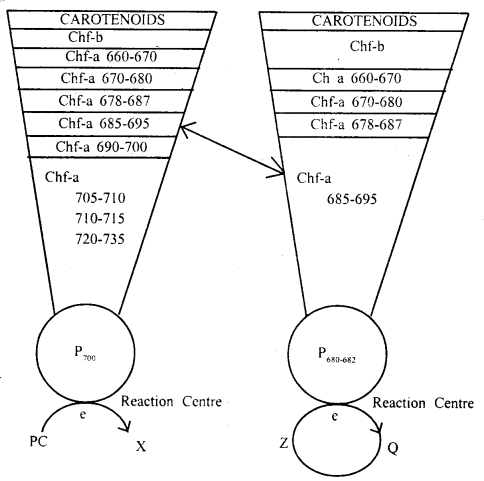
Distribution of pigment in photosystem I and
Photosystem II.
Question 5.
What led to the evolution of the C4 pathway of
photosynthesis? Describe in detail.
Answer:
Kortschak (1965) observed that
in sugarcane, the compound in which CO, got incorporated was oxaloacetic acid or
oxaloacetate (OAA), a 4-carbon compound instead of phosphoglyceric acid, a
3-carbon com¬pound.
Hatch and Slack (1965-1967) found it a regular mode of CO2 fIxation in a number of monocots such as sugar cane, maize, sorghum, and Pennisetum. They found that the initial acceptor of CO2 in such plants is Phosphoenalpymvic acid instead of RuBP and the first stable compound is oxaloacetate acid, a 4-carbon compound. These plants are termed C4 plants as the first stable compound is a 4-carbon compound and other plants are termed C3 plants.
Hatch and Slack observed that these plants have another pathway of CO2 a fixation that precedes the Calvin cycle occurring in C3 plants. This cycle is known as the C4 pathway.
Question 6.
Describe in detail how ATP and NADPH2 are formed during
photochemical reactions?
Answer:
Photosynthesis at present is thus
considered basically an oxidation-reduction process during which water is
oxidized to release oxygen and CO2 is reduced to carbohydrates.
Photosynthesis involves two steps- the first step is light-dependent called
Light reaction or Hill reaction or photochemical phase. The second step is the
Dark reaction or Blankman’s reaction or the Biosynthetic phase, which does
require light.
Light Reaction or Hill Reaction: During this process, solar energy is converted into chemical energy, light is trapped by chlorophyll and carotenoid pigments and is converted into chemical energy which is stored in the form of ATP energy-rich molecule.
Photolysis of water occurs that leads to the evolution of oxygen and formation of H+ ions, the latter combining with NADP to form NADPH2 often termed as reducing power. ATP and NADPH together termed assimilatory power as CO2 fixation during the dark reaction.
Photolysis of water takes place in presence of light and water oxidizing
enzyme as follow:
The unstable OH” combines to form water and
molecular oxygen after losing the electrons which are accepted by oxidized
chlorophyll molecule. (P680 of PS11) through an unknown
electron acceptor compound “Z”. This step requires the presence of
Mn++ and Cl’ ions.